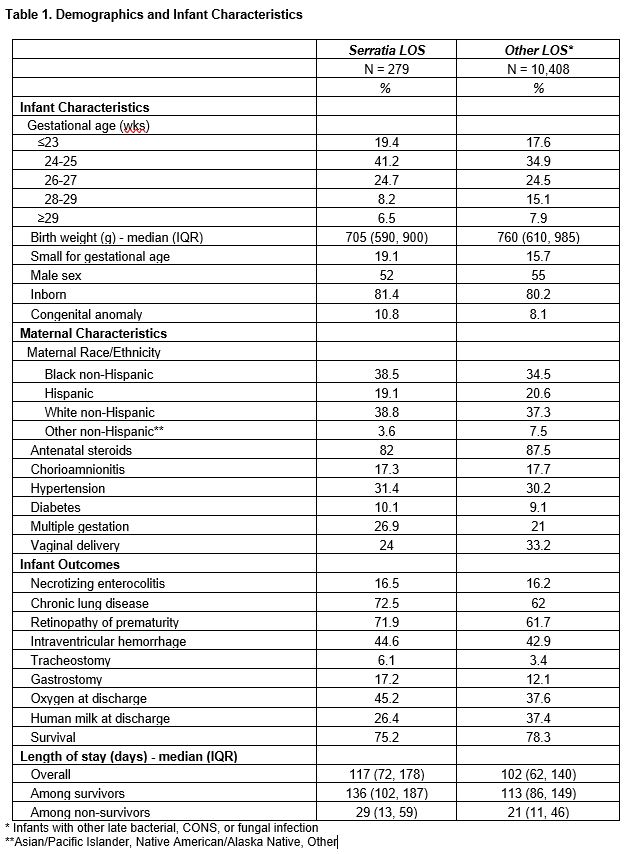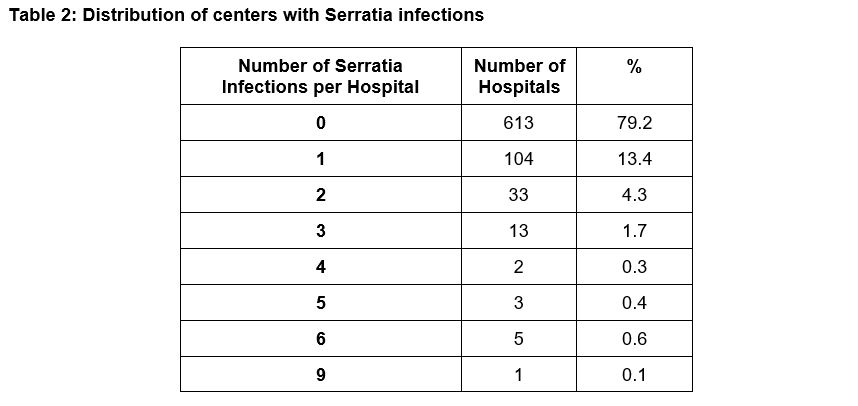Neonatal Infectious Diseases/Immunology
Category: Abstract Submission
Neonatal Infectious Diseases/Immunology: Potpourri
564 - Serratia infection epidemiology among very preterm infants
Sunday, April 24, 2022
3:30 PM - 6:00 PM US MT
Poster Number: 564
Publication Number: 564.336
Publication Number: 564.336
Sarah A. Coggins, Childrens Hospital of Philadelphia, Philadelphia, PA, United States; Dustin D. Flannery, Childrens Hospital of Philadelphia, Philadelphia, PA, United States; Erika M. Edwards, Robert Larner, M.D., College of Medicine at the University of Vermont, Burlington, VT, United States; Jeffrey D. Horbar, Larner College of Medicine University of Vermont, Burlington, VT, United States; Karen M. Puopolo, Childrens Hospital of Philadelphia, Philadelphia, PA, United States

Sarah A. Coggins, MD, MSCE
Neonatologist
Children's Hospital of Philadelphia
Philadelphia, Pennsylvania, United States
Presenting Author(s)
Background: Serratia spp. are opportunistic Gram-negative pathogens that have emerged as important nosocomial infections, with environmental reservoirs including medical equipment, water sources, and colonized patients and hospital personnel. Most reports of neonatal Serratia infections are from single centers and describe infection clusters or outbreak patterns. In small studies, neonatal Serratia infections are associated with increased morbidity and mortality, compared to other infections.
Objective: To describe the epidemiology of late-onset Serratia infections among preterm infants among a contemporary, nationally representative cohort.
Design/Methods: Prospective observational study of very preterm infants born 401 to 1500 grams and/or 22 to 29 weeks’ GA admitted from 2018-2020 at 774 Vermont Oxford Network centers. Late-onset infection was defined as culture-confirmed blood and/or CSF infection >3 days after birth. Demographics, clinical and hospital characteristics, and patient outcomes were compared between infants with Serratia and non¬-Serratia infections.
Results: Of 119,565 very preterm infants, 10,687 (8.9%) had late-onset infection, of which 279 were caused by Serratia (2.6% of all infections, 26 Serratia cases per 1000 infections, 2.3 Serratia cases per 1000 very preterm births). Infants with Serratia infections had lower gestational age; 61% were born at ≤ 25 weeks’ gestation. Infants with Serratia had higher rates of neonatal morbidities including chronic lung disease (73% vs 62%) and retinopathy of prematurity (72% vs 62%) compared to those with non-Serratia infections (Table 1). Infants with Serratia infections also had higher rates of tracheostomy (6% vs 3%), home oxygen (45% vs 38%), and lower rates of human milk feeding at discharge (26% vs 37%) compared to those with non-Serratia infection. Survival to discharge was similar between the two groups (75% vs 78%).
Of 774 hospitals, 161 (21%) had at least one Serratia infection (Table 2). Of these, 61% occurred at hospitals reporting only 1 or 2 Serratia infections for the study period; 19% of infections occurred at hospitals reporting ≥5 Serratia infections.Conclusion(s): To date, this is the largest report describing Serratia epidemiology in neonatal intensive care units. In contrast to prior reports, most infections in this nationally representative cohort appeared to occur sporadically, rather than as outbreaks. Significant morbidity among survivors reinforces the need for recognition and targeted prevention strategies for this opportunistic nosocomial infection.
Table 1: Demographics and Infant Characteristics
Table 2: Distribution of centers with Serratia infections
Objective: To describe the epidemiology of late-onset Serratia infections among preterm infants among a contemporary, nationally representative cohort.
Design/Methods: Prospective observational study of very preterm infants born 401 to 1500 grams and/or 22 to 29 weeks’ GA admitted from 2018-2020 at 774 Vermont Oxford Network centers. Late-onset infection was defined as culture-confirmed blood and/or CSF infection >3 days after birth. Demographics, clinical and hospital characteristics, and patient outcomes were compared between infants with Serratia and non¬-Serratia infections.
Results: Of 119,565 very preterm infants, 10,687 (8.9%) had late-onset infection, of which 279 were caused by Serratia (2.6% of all infections, 26 Serratia cases per 1000 infections, 2.3 Serratia cases per 1000 very preterm births). Infants with Serratia infections had lower gestational age; 61% were born at ≤ 25 weeks’ gestation. Infants with Serratia had higher rates of neonatal morbidities including chronic lung disease (73% vs 62%) and retinopathy of prematurity (72% vs 62%) compared to those with non-Serratia infections (Table 1). Infants with Serratia infections also had higher rates of tracheostomy (6% vs 3%), home oxygen (45% vs 38%), and lower rates of human milk feeding at discharge (26% vs 37%) compared to those with non-Serratia infection. Survival to discharge was similar between the two groups (75% vs 78%).
Of 774 hospitals, 161 (21%) had at least one Serratia infection (Table 2). Of these, 61% occurred at hospitals reporting only 1 or 2 Serratia infections for the study period; 19% of infections occurred at hospitals reporting ≥5 Serratia infections.Conclusion(s): To date, this is the largest report describing Serratia epidemiology in neonatal intensive care units. In contrast to prior reports, most infections in this nationally representative cohort appeared to occur sporadically, rather than as outbreaks. Significant morbidity among survivors reinforces the need for recognition and targeted prevention strategies for this opportunistic nosocomial infection.
Table 1: Demographics and Infant Characteristics

Table 2: Distribution of centers with Serratia infections

